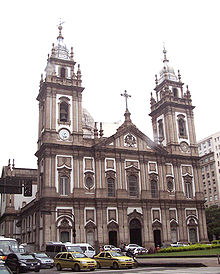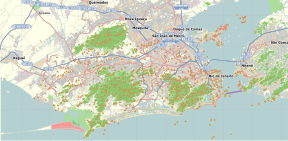Candelária massacre
This article includes a list of general references, but it lacks sufficient corresponding inline citations. (June 2018) |

The Candelária massacre (Portuguese: chacina da Candelária [ʃɐˈsĩnɐ ðɐ kɐ̃deˈlaɾjɐ]) was a mass killing in Rio de Janeiro, Brazil, on July 23, 1993. During the night, eight homeless people, including six minors, were killed by a group of men beside the Candelária Church. Several of the men were members of the police and were tried for the killings, but only two were convicted.
Background[edit]
The Candelária Church is a famous historic Roman Catholic church in central Rio de Janeiro, Brazil. The church itself and the buildings around it in Pius X Square became known as a popular location for possibly hundreds of Rio de Janeiro's street children to form a makeshift home at night. The church's personnel provides food, shelter, education and religious advice to as many of these children as possible. Many of the homeless children are involved with the illegal drug trade and prostitution, and because many of these children also live around the church during the day, police keep a constant watch on the church's surroundings. In the early 1990s, the area around the Candelária Church developed a high crime rate as street children increasingly began to commit criminal activities such as pickpocketing and robbery.
Massacre[edit]
According to survivors, on the morning of July 22, 1993, the day before the massacre, a group of children threw stones at police cars. As the children from the Candelária Church area were usually only given warnings by policemen, the young perpetrators left without worrying too much about the threat. At midnight, several Chevrolet Chevette cars with covered license plates came to a halt in front of the Candelária Church, and the occupants began shooting at the group of roughly seventy street children sleeping in the vicinity of the church.[1]
Subsequently in the investigations, it was found that the shots were fired by militiamen, that used the square around the church as a selling point for drugs. As a result, six minors and two adults died and several children and teenagers got injured.[2] According to studies conducted by associations connected to the Amnesty International, forty four of the seventy people that slept in the streets of that region lost their lives in a violent manner. The majority of the vitims were poor and black.[3]
List of those killed[edit]
The names of the eight victims are inscribed in a wooden cross, erected in the garden across the church:
- Paulo Roberto de Oliveira, 11 years old
- Anderson de Oliveira Pereira, 13 years old
- Marcelo Cândido de Jesus, 14 years old
- Valdevino Miguel de Almeida, 14 years old
- "Gambazinho", 17 years old
- Leandro Santos da Conceição, 17 years old
- Paulo José da Silva, 18 years old
- Marcos Antônio Alves da Silva, 19 years old
Aftermath[edit]
The investigation led the police to Wagner dos Santos, one of the teenagers that survived, even though he was hit four times. Santos would suffer a second attack on September 12, 1994, in the Central do Brasil and from then on, the Prosecutor's Office put him on the Witness Protection Program. His testimony was fundamental in the recognition of those involved. Wagner left the country with the help of the federal government and suffers from serious health problems.[3]
During the case, seven people were indicted: the former military police officer Marcus Vinícius Emmanuel Borges, the Military Policemen Cláudio dos Santos and Marcelo Cortes, the locksmith Jurandir Gomes França, Nelson Oliveiras dos Santos, Marco Aurélio Dias de Alcântara and Arlindo Afonso Lisboa Júnior.
- Cláudio, Marcelo and Jurandir were acquitted.
- Arlindo hasn't been tried for the mass killing, having been sentenced to two years for having possession of one of the crime weapons.
- The other three, already convicted, remain free, benefited by pardon or parole.
- Marcus Vinicius Emmanuel Borges, a former military police officer - was sentenced to 309 years. He appealed the sentence and, in a second trial, was sentenced to 89 years. Unsatisfied with the result, the Prosecutor's Office asked for a new trial and, in February of 2003, Emmanuel was sentenced to 300 years but remains free;[4]
- Nelson Oliveira dos Santos - was sentenced to 243 years in prison for the killings and 18 years for attempted murder Wagner dos Santos. He appealed his sentence, being absolved for the killings even after confessing to the crime. The Prosecuto's Office appealed and, in the year 2000, Nelson was sentenced to 27 years for the killings and the attempted murder charge was kept, adding up to 45 years. Nelson Oliveira dos Santos was initially released but is currently on parole for other crimes, according to the Justice Court of Rio;[4]
- Marco Aurélio Dias de Alcântara - was sentenced to 204 years in prison and was also released from jail.
The international community severely condemned the attack, and many in Brazil asked for the prosecution of those who shot the Candelária Church children.
The event was addressed by the Brazilian death metal band Lacerated and Carbonized in the song "The Candelária Massacre" from their 2013 album The Core of Disruption. Blaggers ITA did the same in their 1993 single "Oxygen" [5]
Survivors[edit]
A social worker who later tracked the fate of these homeless survivors of the Candelária massacre found out that eventually 39 of them were either killed by police or by elements of street life, and discusses this in the documentary Bus 174 about the Nascimento incident.
See also[edit]
References[edit]
- ^ "Linha Direta Justiça - Casos - Rede Globo". redeglobo.globo.com. Retrieved 2024-05-18.
- ^ "'Quando cheguei ao meio-fio, vi todo mundo morrendo': vítimas da Chacina da Candelária narram impactos em suas vidas". Marie Claire (in Brazilian Portuguese). 2023-07-31. Retrieved 2024-05-18.
- ^ a b "Paradeiro de sobreviventes da chacina da Candelária é desconhecido - 23/07/2013 - Cotidiano". Folha de S.Paulo. 2024-05-18. Retrieved 2024-05-18.
- ^ a b "Chicago Tribune". Chicago Tribune. Archived from the original on 2022-09-20.
- ^ Blaggers ITA - Oxygen
External links[edit]
- Movie review and director interview
- Amnesty International report and information
- Brazilian trooper convicted of slaughtering street children, CNN.com, May 1, 1996
- Trial begins for Rio police accused of killing homeless kids, CNN.com, December 9, 1996
- Killing of 4 Beggars Shocks Rio And Recalls Earlier Massacre, New York Times, December 12, 1997
- Police brutality in Brazil
- 1993 in Brazil
- 20th century in Rio de Janeiro
- Mass murder in 1993
- Massacres in 1993
- July 1993 events in South America
- July 1993 crimes
- Mass shootings in Brazil
- Massacres in Brazil
- Church massacres
- Street children
- 1993 murders in Brazil
- 1993 mass shootings in South America
- Attacks on churches in South America

